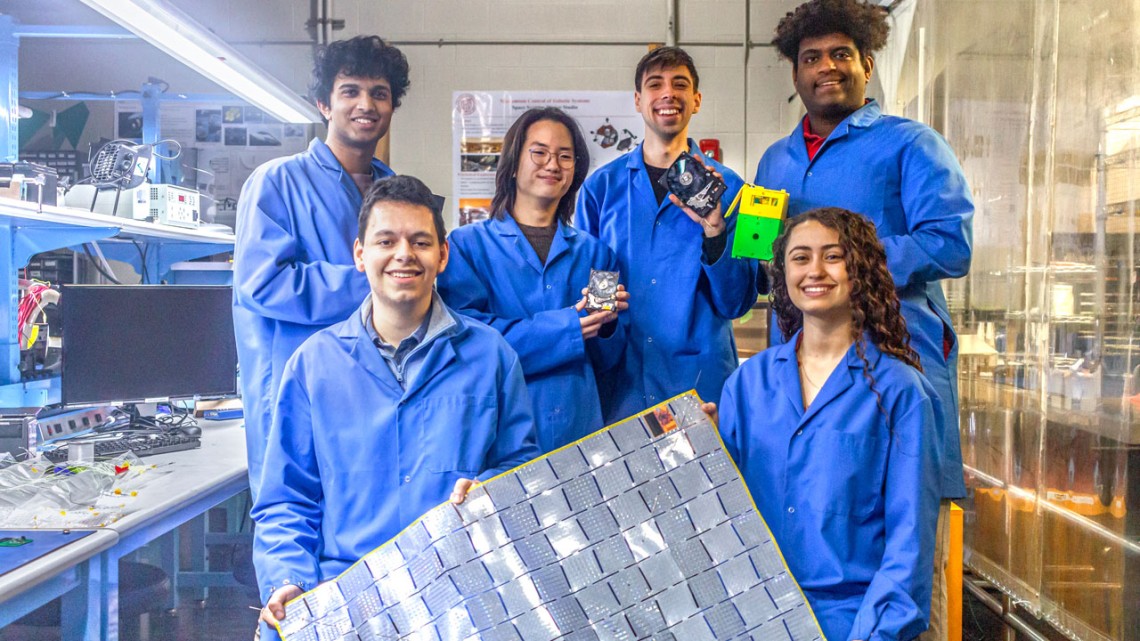
Cornell students and founding members of Sailing to the Stars, from left: Raghav Inder, Ethan Francolla, Ryan Lee, Joshua Umansky-Castro, Verena Padres and Adam Yonas.
Cornell light sail to deploy on International Space Station
By Syl Kacapyr
A light sail that could one day propel small spacecraft through interstellar realms is headed to the International Space Station and will be tested by astronauts on behalf of Cornell’s Space Systems Design Studio.
Much like a sailboat harnesses wind to travel across an ocean, light sails use the momentum of sunlight to travel through space. The “Sailing to the Stars” project is Cornell’s unique version of a light sail that includes a poster-size sheet of microprismatic retroreflective film equipped with “ChipSat” spacecraft – miniature satellites that weigh only 2.5 grams and can transmit data to Earth. The size of the sail, combined with its shape-memory alloy frame, allows it to fold inside a small deployer that can eject the sail, with the goal of sending it on a journey to nearby planets and, possibly one day, another star system.
“By employing ChipSats as the sail’s flight computers, and modulated piezoelectric retroreflector panels as the steering mechanism, our sail architecture is not only much smaller than traditional light sails, but capable of much higher acceleration,” said Joshua Umansky-Castro, a doctoral student in aerospace engineering and co-investigator for the project. “But before this technology can be widely used, we need to better understand how the design of the deployer and use of the frame affect attitude kinematics.”
The sail’s deployment dynamics will be tested in microgravity, thanks to a grant from the Center for the Advancement of Science in Space’s International Space Station National Laboratory. Umansky-Castro and others from the Space Systems Design Studio are now engineering new versions of their light sails and deployers for the experiment.
The principal investigator for the project is Mason Peck, the Stephen J. Fujikawa ’77 Professor of Astronautical Engineering. Leading the project is Verena Padres ’26, a mechanical and aerospace engineering student who said the Cornell team is working with its partners to have the experiment ready for launch by 2025.
“One of the most exciting things about leading this mission is being able to see this project all the way through, from refining the early mission concept to eventually watching the tests that will be conducted on the ISS,” said Padres, who has been involved with the development of each subsystem for the light sail deployers. “We have solved some pretty difficult challenges and have made great progress these past couple of months, and I couldn’t be more confident in the work the team is doing.”
Ultimately, the Cornell team plans to use the light sail for its upcoming Alpha CubeSat mission, which will be the first to demonstrate a ChipSat-sail architecture in orbit.
While the team is focused on developing new technologies, it is also developing the people behind the technologies as part of the space station grant’s education and workforce development mission.
“While the spacecraft are small, they are incredibly complex. I could not have gotten this far without the support of my undergraduate, M.Eng. and M.S. students,” said Umansky-Castro, who recently welcomed the 100th undergraduate student to work with him at Cornell. “I’m very thankful for the community that I’ve formed here. The energy and enthusiasm my students bring to the lab have motivated me to keep up the pace as we bring projects closer to the launch pad.”
Students from the Space Systems Design Studio are also finding mentorship from Silicon Valley engineers Andrew Filo and Alex Burke, who have been meeting with the team weekly. As a former NASA consultant and the designer of the light sail, Filo is a co-principal investigator on the Sailing with the Stars experiment.
As part of the education and outreach goals of the project, the Space Systems Design Studio is planning educational workshops and other events with its partners, which include Cornell Diversity Programs in Engineering, the Society for the Advancement of Chicanos/Hispanics and Native Americans in STEM, Women of Aeronautics and Astronautics, Skyline Celestial, Modulated Retroreflective Technologies Corp., Creativity Inc., Avery Dennison, Rhodium Scientific, the Intrepid Museum and the Hiller Aviation Museum.
Syl Kacapyr is associate director of marketing and communications for Cornell Engineering.
Media Contact
Get Cornell news delivered right to your inbox.
Subscribe
